
The Milky Way Galaxy itself is also a barred spiral (probably of the classification SBc) as is one of its attendant galaxies, the Large Magellanic Cloud, which is a distorted irregular galaxy of the SBm classification. Some examples of barred spiral galaxies include M91 in Coma Berenices, M109 in Ursa Major, and NGC 1300 in Eridanus (an SBc galaxy with a highly distinct bar structure). The variant class SAB is used for barred galaxies with an especially indistinct bar, known as intermediate or weakly barred spirals.


#Barred spiral galaxy sba full#
At one end of this scale, SBa galaxies have tightly wound arms around a relatively small and often indistinct bar, while SBc galaxies have a quite distinct elongated bar extending out across much of their diameter.Ī fourth specialised category, SBm, describes irregular galaxies that nonetheless show some barred structure ( galaxies of this kind are thought to have typically originated as full barred spirals and been distorted by external forces). There are three classical subcategories, SBa, SBb and SBc, describing the structure in more detail. On the Hubble Classification, barred spirals are categorised as 'SB' (rather than just ' S' for simple spirals). The barred structure also has the effect of concentrating material in the regions of the galaxy's nucleus. These galaxies still have spiral arms, but those arms extend from the outer ends of the bar, and not directly from the central core. Tidal gravitational forces around the central bulge cause the orbits of stars in that region to become synchronised, so that a distinct bar forms, extending outward laterally from the core on either side. Many galaxies, however (in fact, up to two thirds of all spiral galaxies) have a more complex form. Galaxy evolution is a far more complex process than Hubble imagined, involving the conditions of the galaxy's initial collapse, collisions with other galaxies, and the ebb and flow of internal star birth.A typical simple spiral galaxy has a central bulge at the core, with galactic arms spiralling outward from that bulge. Spiral galaxies are classified as Sa/SBa, Sb/SBb or Sc/SBc (classic/barred) according to the tightness of their spiral, the clumpiness of their spiral arms, and. Hence "Sa" and "SBa" galaxies were called "early-type," while "Sc" and "SBc" were called "late-type."Īstronomers still use this nomenclature today, though the initial concept was later found to be an over-simplification.

Those include irregular galaxies which have odd shapes, dwarf galaxies which are very small, and giant elliptical galaxies which are very large elliptical galaxies residing in the centers of some clusters of galaxies.įor a time the Hubble tuning fork was thought to be an evolutionary sequence - that galaxies might evolve from one type to another progressing from left to right across the tuning-fork diagram. Hubble found that some galaxies are difficult to put in the context of the tuning fork diagram. "S0," or lenticular galaxies, are in the transition zones between ellipticals and spirals and bridge these two types. An "SBc" is thus a loosely wound barred spiral galaxy. Barred spirals have a "B" in their classification. The spiral arms in barred spirals usually start at the end of the bar instead of from the bulge. The most important difference between these two groups is the bar of stars that runs through the central bulge in barred spirals. In fact the spiral galaxies are sub-divided into two groups - normal spirals and barred spirals. There are indications pointing to a very close connection between the bulges of certain galaxies (Hubble types "S0", "Sa" and "Sb") and elliptical galaxies.

Also it is worth noting that the sizes of the round central regions in spirals - the so-called bulges - increase in size the more tightly the spiral arms are wound. "Sa" spirals, for example, are tightly wound whereas "Sc" spirals are more loosely wound. The spirals were assigned letters from "a" to "c," which characterize the compactness of their spiral arms. Hubble gave the ellipticals numbers from zero to seven, which characterize the ellipticity of the galaxy - "E0" is almost round, "E7" is very elliptical. The diagram is roughly divided into two parts: elliptical galaxies (ellipticals) and spiral galaxies (spirals). Although this scheme, also known as the Hubble tuning fork diagram, is now considered somewhat too simple, the basic ideas still hold. As one of the first steps towards a coherent theory of galaxy evolution, the American astronomer Edwin Hubble, developed a classification scheme of galaxies in 1926. Some are simple, while others are very complex in structure. Galaxies are very important fundamental building blocks of the Universe. The Hubble tuning fork - Classification of galaxies


 0 kommentar(er)
0 kommentar(er)
